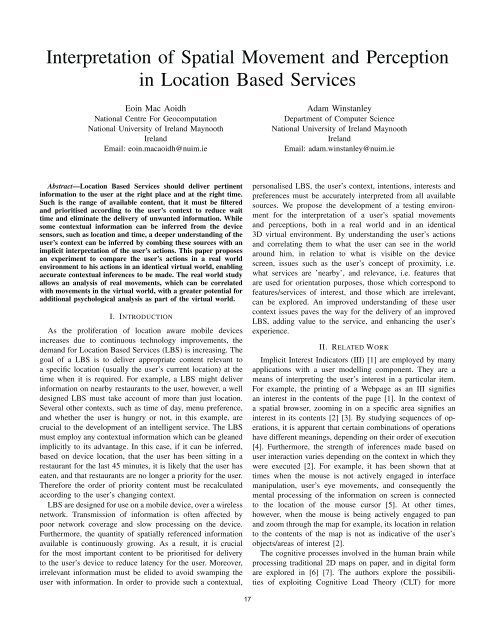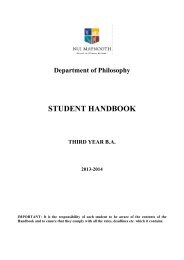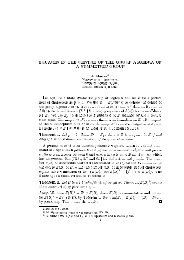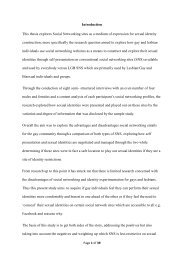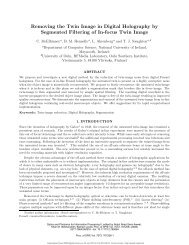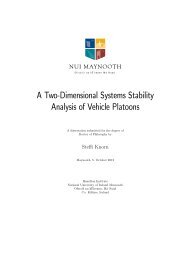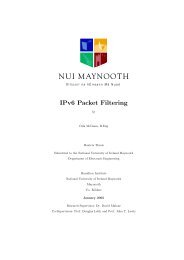CIICT 2009 Proceedings
CIICT 2009 Proceedings
CIICT 2009 Proceedings
- No tags were found...
Create successful ePaper yourself
Turn your PDF publications into a flip-book with our unique Google optimized e-Paper software.
Interpretation of Spatial Movement and Perceptionin Location Based ServicesEoin Mac AoidhNational Centre For GeocomputationNational University of Ireland MaynoothIrelandEmail: eoin.macaoidh@nuim.ieAdam WinstanleyDepartment of Computer ScienceNational University of Ireland MaynoothIrelandEmail: adam.winstanley@nuim.ieAbstract—Location Based Services should deliver pertinentinformation to the user at the right place and at the right time.Such is the range of available content, that it must be filteredand prioritised according to the user’s context to reduce waittime and eliminate the delivery of unwanted information. Whilesome contextual information can be inferred from the devicesensors, such as location and time, a deeper understanding of theuser’s context can be inferred by combing these sources with animplicit interpretation of the user’s actions. This paper proposesan experiment to compare the user’s actions in a real worldenvironment to his actions in an identical virtual world, enablingaccurate contextual inferences to be made. The real world studyallows an analysis of real movements, which can be correlatedwith movements in the virtual world, with a greater potential foradditional psychological analysis as part of the virtual world.I. INTRODUCTIONAs the proliferation of location aware mobile devicesincreases due to continuous technology improvements, thedemand for Location Based Services (LBS) is increasing. Thegoal of a LBS is to deliver appropriate content relevant toa specific location (usually the user’s current location) at thetime when it is required. For example, a LBS might deliverinformation on nearby restaurants to the user, however, a welldesigned LBS must take account of more than just location.Several other contexts, such as time of day, menu preference,and whether the user is hungry or not, in this example, arecrucial to the development of an intelligent service. The LBSmust employ any contextual information which can be gleanedimplicitly to its advantage. In this case, if it can be inferred,based on device location, that the user has been sitting in arestaurant for the last 45 minutes, it is likely that the user haseaten, and that restaurants are no longer a priority for the user.Therefore the order of priority content must be recalculatedaccording to the user’s changing context.LBS are designed for use on a mobile device, over a wirelessnetwork. Transmission of information is often affected bypoor network coverage and slow processing on the device.Furthermore, the quantity of spatially referenced informationavailable is continuously growing. As a result, it is crucialfor the most important content to be prioritised for deliveryto the user’s device to reduce latency for the user. Moreover,irrelevant information must be elided to avoid swamping theuser with information. In order to provide such a contextual,personalised LBS, the user’s context, intentions, interests andpreferences must be accurately interpreted from all availablesources. We propose the development of a testing environmentfor the interpretation of a user’s spatial movementsand perceptions, both in a real world and in an identical3D virtual environment. By understanding the user’s actionsand correlating them to what the user can see in the worldaround him, in relation to what is visible on the devicescreen, issues such as the user’s concept of proximity, i.e.what services are ’nearby’, and relevance, i.e. features thatare used for orientation purposes, those which correspond tofeatures/services of interest, and those which are irrelevant,can be explored. An improved understanding of these usercontext issues paves the way for the delivery of an improvedLBS, adding value to the service, and enhancing the user’sexperience.II. RELATED WORKImplicit Interest Indicators (III) [1] are employed by manyapplications with a user modelling component. They are ameans of interpreting the user’s interest in a particular item.For example, the printing of a Webpage as an III signifiesan interest in the contents of the page [1]. In the context ofa spatial browser, zooming in on a specific area signifies aninterest in its contents [2] [3]. By studying sequences of operations,it is apparent that certain combinations of operationshave different meanings, depending on their order of execution[4]. Furthermore, the strength of inferences made based onuser interaction varies depending on the context in which theywere executed [2]. For example, it has been shown that attimes when the mouse is not actively engaged in interfacemanipulation, user’s eye movements, and consequently themental processing of the information on screen is connectedto the location of the mouse cursor [5]. At other times,however, when the mouse is being actively engaged to panand zoom through the map for example, its location in relationto the contents of the map is not as indicative of the user’sobjects/areas of interest [2].The cognitive processes involved in the human brain whileprocessing traditional 2D maps on paper, and in digital formare explored in [6] [7]. The authors explore the possibilitiesof exploiting Cognitive Load Theory (CLT) for more17


